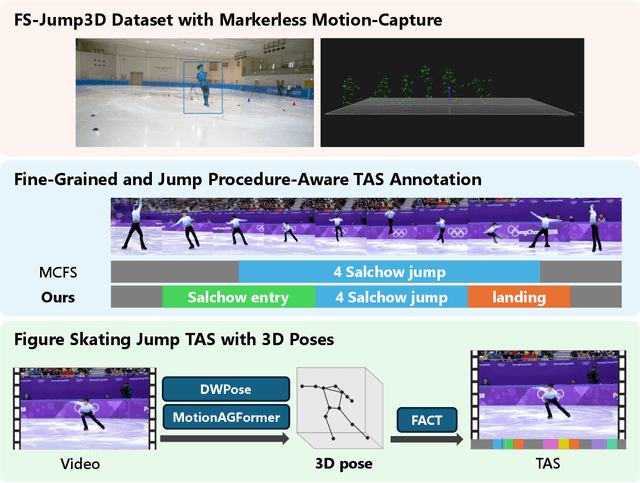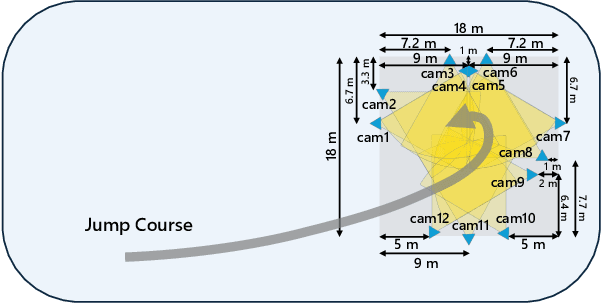Tomohiro Suzuki
AthletePose3D: A Benchmark Dataset for 3D Human Pose Estimation and Kinematic Validation in Athletic Movements
Mar 11, 2025Abstract:Human pose estimation is a critical task in computer vision and sports biomechanics, with applications spanning sports science, rehabilitation, and biomechanical research. While significant progress has been made in monocular 3D pose estimation, current datasets often fail to capture the complex, high-acceleration movements typical of competitive sports. In this work, we introduce AthletePose3D, a novel dataset designed to address this gap. AthletePose3D includes 12 types of sports motions across various disciplines, with approximately 1.3 million frames and 165 thousand individual postures, specifically capturing high-speed, high-acceleration athletic movements. We evaluate state-of-the-art (SOTA) monocular 2D and 3D pose estimation models on the dataset, revealing that models trained on conventional datasets perform poorly on athletic motions. However, fine-tuning these models on AthletePose3D notably reduces the SOTA model mean per joint position error (MPJPE) from 214mm to 65mm-a reduction of over 69%. We also validate the kinematic accuracy of monocular pose estimations through waveform analysis, highlighting strong correlations in joint angle estimations but limitations in velocity estimation. Our work provides a comprehensive evaluation of monocular pose estimation models in the context of sports, contributing valuable insights for advancing monocular pose estimation techniques in high-performance sports environments. The dataset, code, and model checkpoints are available at: https://github.com/calvinyeungck/AthletePose3D
3D Pose-Based Temporal Action Segmentation for Figure Skating: A Fine-Grained and Jump Procedure-Aware Annotation Approach
Aug 29, 2024



Abstract:Understanding human actions from videos is essential in many domains, including sports. In figure skating, technical judgments are performed by watching skaters' 3D movements, and its part of the judging procedure can be regarded as a Temporal Action Segmentation (TAS) task. TAS tasks in figure skating that automatically assign temporal semantics to video are actively researched. However, there is a lack of datasets and effective methods for TAS tasks requiring 3D pose data. In this study, we first created the FS-Jump3D dataset of complex and dynamic figure skating jumps using optical markerless motion capture. We also propose a new fine-grained figure skating jump TAS dataset annotation method with which TAS models can learn jump procedures. In the experimental results, we validated the usefulness of 3D pose features as input and the fine-grained dataset for the TAS model in figure skating. FS-Jump3D Dataset is available at https://github.com/ryota-skating/FS-Jump3D.
Runner re-identification from single-view video in the open-world setting
Oct 18, 2023Abstract:In many sports, player re-identification is crucial for automatic video processing and analysis. However, most of the current studies on player re-identification in multi- or single-view sports videos focus on re-identification in the closed-world setting using labeled image dataset, and player re-identification in the open-world setting for automatic video analysis is not well developed. In this paper, we propose a runner re-identification system that directly processes single-view video to address the open-world setting. In the open-world setting, we cannot use labeled dataset and have to process video directly. The proposed system automatically processes raw video as input to identify runners, and it can identify runners even when they are framed out multiple times. For the automatic processing, we first detect the runners in the video using the pre-trained YOLOv8 and the fine-tuned EfficientNet. We then track the runners using ByteTrack and detect their shoes with the fine-tuned YOLOv8. Finally, we extract the image features of the runners using an unsupervised method using the gated recurrent unit autoencoder model. To improve the accuracy of runner re-identification, we use dynamic features of running sequence images. We evaluated the system on a running practice video dataset and showed that the proposed method identified runners with higher accuracy than one of the state-of-the-art models in unsupervised re-identification. We also showed that our unsupervised running dynamic feature extractor was effective for runner re-identification. Our runner re-identification system can be useful for the automatic analysis of running videos.
Automatic detection of faults in race walking from a smartphone camera: a comparison of an Olympic medalist and university athletes
Aug 24, 2022



Abstract:Automatic fault detection is a major challenge in many sports. In race walking, referees visually judge faults according to the rules. Hence, ensuring objectivity and fairness while judging is important. To address this issue, some studies have attempted to use sensors and machine learning to automatically detect faults. However, there are problems associated with sensor attachments and equipment such as a high-speed camera, which conflict with the visual judgement of referees, and the interpretability of the fault detection models. In this study, we proposed a fault detection system for non-contact measurement. We used pose estimation and machine learning models trained based on the judgements of multiple qualified referees to realize fair fault judgement. We verified them using smartphone videos of normal race walking and walking with intentional faults in several athletes including the medalist of the Tokyo Olympics. The validation results show that the proposed system detected faults with an average accuracy of over 90%. We also revealed that the machine learning model detects faults according to the rules of race walking. In addition, the intentional faulty walking movement of the medalist was different from that of university walkers. This finding informs realization of a more general fault detection model. The code and data are available at https://github.com/SZucchini/racewalk-aijudge.
 Add to Chrome
Add to Chrome Add to Firefox
Add to Firefox Add to Edge
Add to Edge